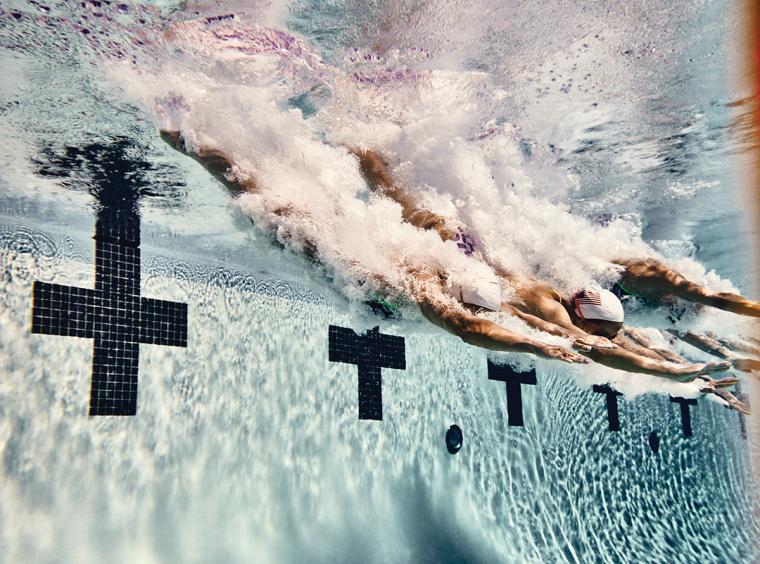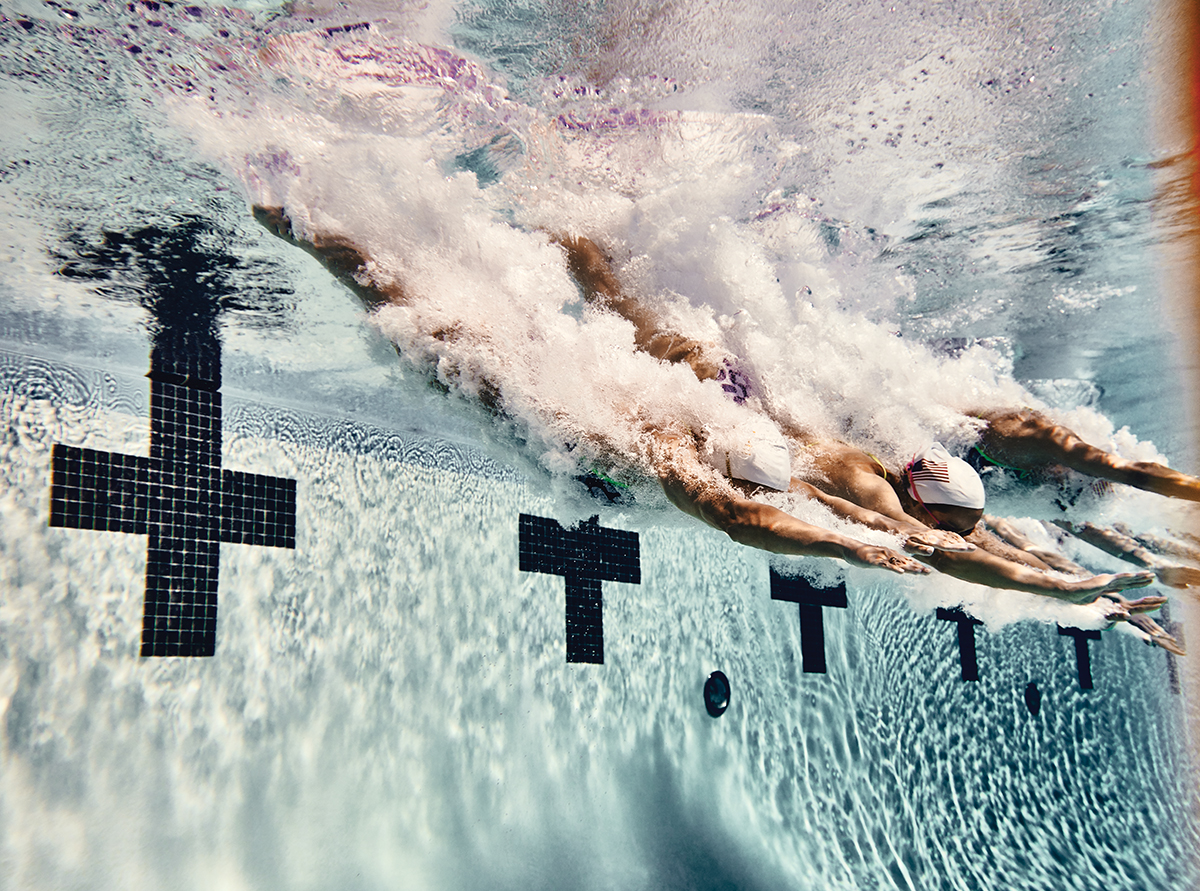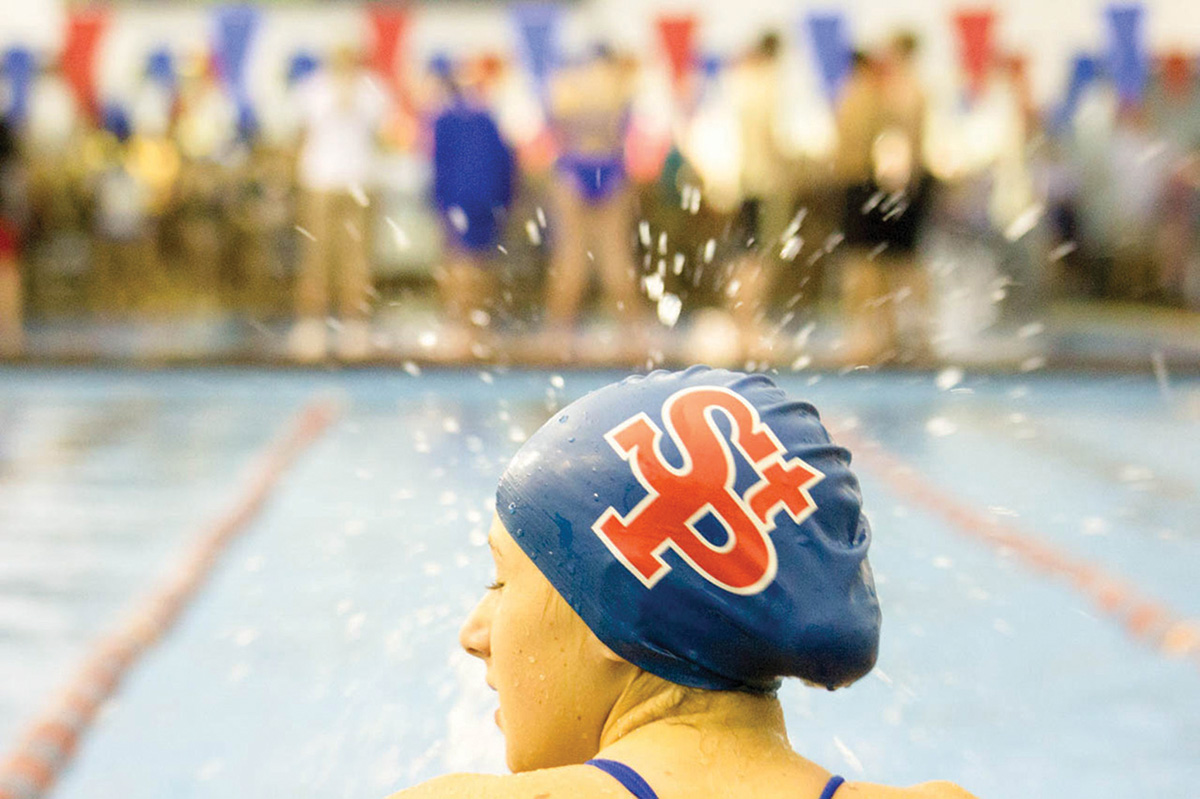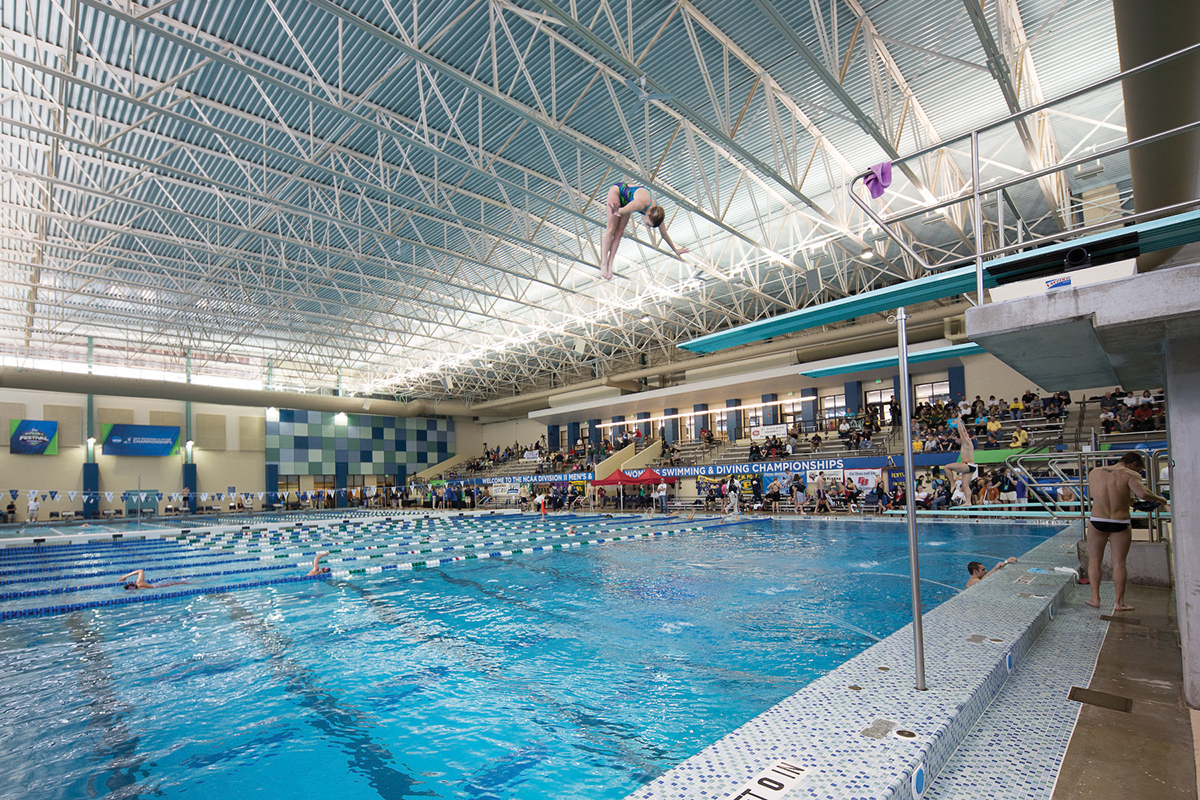

“We have a big swim following here,” says Susan Shaw, marketing and sports event director for the Mobile Sports Authority. “Any time you have a group of really strong athletes, you have a great group of parents behind them who passionately drive the sport.”
The CMSA uses several swim facilities in the area for practices and hosts meets at the Fredericka G. Evans Cultural Centre at Bishop State Community College. There have been additional discussions about the club building its own facility.
“To be fully transparent, we’re not currently at the level we’d like to be,” Shaw says. “But people are still surprised to see the facilities we do have.”
The 50-meter, six-lane pool with movable bulkhead at the Fredericka G. Evans Cultural Centre offers seating for 800 spectators and hosts meets that attract club and high school teams from neighboring Southeastern states. Shaw says the swim association and the sports authority are working to increase Mobile’s swimming presence on a wider level, and she’s hopeful recent discussions about a building a new facility reach fruition, which would provide the impetus to bring even bigger meets to the city.
“We want to show swimming-event rights holders that we’re committed to growing the sport,” Shaw says.
 Mobile is not the only city recognizing the splash that aquatics events can make in local communities. From two cities in Texas that both begin with “L” (Lewisville and Lubbock) north to Mankato, Minnesota, and from coast (Placer Valley, California) to coast (Greenville, South Carolina), many destinations around the country are getting their feet wetter every year.
Mobile is not the only city recognizing the splash that aquatics events can make in local communities. From two cities in Texas that both begin with “L” (Lewisville and Lubbock) north to Mankato, Minnesota, and from coast (Placer Valley, California) to coast (Greenville, South Carolina), many destinations around the country are getting their feet wetter every year.
Big in Texas
Both Lewisville and Lubbock boast major aquatics facilities that helped those cities become emerging swimming and diving markets.
“We’re in the middle of the country, so we make it very attractive to have national competitions here,” says Carlos Hernandez, tourism sports sales coordinator for the Lewisville Convention & Visitors Bureau. “Many of them like to come back here, so we want our aquatics events to be annual things.”
Lewisville’s Westside Aquatic Center, which opened in late 2014 and is owned and operated by the Lewisville Independent School District, is a 75,000-square-foot natatorium that holds 1,200 spectators. It offers a 75-meter competition pool that can accommodate up to 36 lanes, plus two 1-meter and two 3-meter diving boards. In short, it’s ready for all things aquatic and is home to no fewer than seven local organizations, including Lakeside Aquatic Club, Thunder Water Polo and GC Divers.
One of the facility’s first major events was a USA Synchro Junior Olympic regional competition held in April 2015. Since then, the center has consistently hosted similar high-profile events, including the 2017 Speedo Sectionals in March, and Hernandez expects to announce other national and collegiate events soon. He adds that Lewisville also is seeking diving competitions for the Westside Aquatic Center.
Aquatics activities in Lubbock, Texas, revolved around one major facility until recently. The popular Pete Ragus Aquatic Center, owned and operated by the Lubbock Independent School District, opened in 1997 and boasts two eight-lane pools separated by two 3-meter diving boards and three 1-meter boards.
But Southwest Aqua Sports, originally a retail operation for swimming and diving gear, opened a new indoor pool in Lubbock in July 2016. Promoted as “the largest indoor scuba diving and swimming facility in west Texas,” the new privately owned center has yet to host major events and currently is working to increase its profile, according to Scott Harrison, director of sports for Visit Lubbock.
Meanwhile, the Pete Ragus Aquatic Center has undergone two renovations and is as busy as ever. Last year, the Lubbock Dive Club helped bring the 2016 USA Diving Region 11 Championships to the facility, which also is home to several USA Swimming regional meets and the University Interscholastic League’s high school swimming and diving state championships.
“It’s hard to say what new opportunities will open up for us because of the new facility,” Harrison says. “But it will be hard to compete with the Ragus Center, which is what drives swimming and diving in Lubbock right now.”
Coming Soon to Mankato
Speaking of new facilities, a new aquatics center is high on the wish list in Mankato, Minnesota, after residents voted to extend an existing half-cent sales tax last November on purchases made in both Mankato and North Mankato.
The extension, pending approval of the Minnesota Legislature, will provide a source of revenue other than property taxes to pay for recreation amenities. Some of the other venues under consideration include a turf field and an ice rink.
City councils in both communities are looking for community partnerships to help develop and support such facilities, according to Chris Willaert, director of the Mankato Sports Commission. In the meantime, dual and club meets are held at the Highland Center, a six-lane, 25-yard pool with two diving boards on the Minnesota State University Mankato campus. Larger events are held at Gustavus Adolphus College’s Lund Center in nearby Saint Peter. The 25-yard-by-25-meter pool offers 10 lanes, plus 1- and 3-meter diving boards.
There’s room for more. “Aquatics is important to this community, but the dollars have not been spent on infrastructure that should have been spent,” Willaert says. “We don’t have that one facility that would bring a regional championship to Mankato, and that’s what we’re really working toward.”
Coast to Coast
Greenville (South Carolina) County Parks, Recreation & Tourism officials, thanks to their partnership with the Team Greenville swim club, are able to attract several high-profile swimming events to the Westside Aquatic Complex, South Carolina’s only enclosed 50-meter pool. “It’s a great venue, with a warm-up pool, too,” says Robin Wright, senior sales manager for Visit Greenville. “A lot of indoor pools don’t have that.”
The facility, which boasts multiple amenities and serves a variety of community uses, is also a top-notch competitive venue, annually hosting the USA Swimming Southern Zone Age Group Championships, the South Carolina Swimming Short Course Championships and USA Masters Swimming events. The Westside Aquatics Center has a spectator capacity of about 900.
The Roseville Aquatics Complex in the Placer Valley region of Northern California — which includes the cities of Roseville, Rocklin and Lincoln – is similarly well-appointed. The outdoor facility offers an Olympic-size competition pool with bleacher seating for 2,000 and will host the 2017 USA Swimming Western Zone Age Group Championships and the 2018 U.S. Masters Synchronized Swimming Championships. The pool will shut down this fall to undergo $600,000 in updates, including resurfacing, deck replacement and new starting blocks.
Meanwhile, the pool at Sierra College in Rocklin — originally a big draw for synchronized swimming competitions — is emerging as an ideal facility for other aquatics events. “We are using it for everything these days,” says Kim Summers, director of marketing for Placer Valley Tourism, who adds aquatics events join soccer and softball tournaments as the region’s top generators of room nights.
That ranking could climb with the opening of a new 35-meter pool at Del Oro High School that is likely to become a popular water polo destination. A local family raised money for the $2 million project and partnered with Placer Valley Tourism to replace an outdated pool that did not meet standards of the Americans with Disabilities Act, Summers says. A local junior college hosted the first water polo tournament in the Del Oro pool last September, and she expects the facility to host more teams and tournaments in the future.
But even all of that isn’t enough swimming and diving for this aquatics-minded city. “We would love another pool,” Summers says.
Packing the TAC
In Cary, North Carolina, the Triangle Aquatic Center (TAC) is coming off its most active year ever, hosting 28 events that brought approximately $7 million in direct visitor spending to Wake County, according to Jason Philbeck, assistant director of the Greater Raleigh Sports Alliance.
The 72,000-square-foot facility is one of the largest public aquatic centers in North Carolina and boasts three pools: a 50-meter competition pool with seating for 1,000 spectators, a 25-yard program pool and an instructional pool. “TAC is believed to be the largest non-profit public aquatic facility ever built in the country without any tax funding,” Philbeck says.
Over the past 18 months, TAC officials continued to invest in the facility, installing a new 28-foot-by-10-foot color videoboard and a state-of-the-art air cleaning system, as well as enhancing the facility’s technology with fiber wiring to increase Internet speed and updating hardware and software systems.
Annual events at the TAC include the North Carolina High School Athletic Association (NCHSAA) Swimming State Championships and the North Carolina Special Olympics swimming competition. In partnership with the Greater Raleigh Sports Alliance, the facility hosted 550 swimmers at the 2016 USA Swimming Southern Zone Age Group Championships in August.
The 15th annual National Black Heritage Championship Swim Meet will be held at the TAC in May for the ninth consecutive year. More than 700 swimmers from across the country are expected to participate in this event, which Philbeck says generates an estimated $650,000 in direct visitor spending.
Meanwhile, the Pullen Aquatic Center in Raleigh is a 50-meter-by-25-yard pool with mezzanine spectator seating and an outdoor patio. Major events include the NCHSAA Diving State Championships every February, and the facility also hosted the swimming component of the 2015 and 2016 Powerade State Games of North Carolina.
 ‘They Will Come’
‘They Will Come’
How busy is the Birmingham CrossPlex? On a recent weekend, the 750,000-square-foot facility’s natatorium hosted programming for Special Olympics Alabama on a Friday morning, welcomed a triple-dual meet for NCAA Division II and III schools in the afternoon and then held another college dual meet on Saturday.
In fact, the CrossPlex was the impetus for Birmingham-Southern College to begin a swimming and diving program after the facility opened in 2011, according to the facility’s aquatics manager Robby Dellinger.
The pool, which has partnerships with a local USA Swimming club, as well as area YMCAs, high schools and parks and recreation departments, boasts 10 50-meter lanes and 20 25-yard lanes, with two 1-meter and two 3-meter springboards for diving competitions. A moveable fiberglass bulkhead makes it easy to convert the pool for synchronized swimming and water polo events, too. Seating capacity is 1,000 spectators.
The CrossPlex also has become a destination for the NCAA Division II Winter Festival National Championship, an Olympics-style event in which competition for men’s and women’s swimming and diving, men’s and women’s indoor track and wrestling are all held at the same time. The facility first hosted in 2012 and will do so again in March 2017, and it will host the National Senior Games in June.
On top of all that, expansion is on Dellinger’s mind these days, in the form of a second pool or expanded seating. “I know I would get some bigger events if we had more seats,” he says. “It would be like the Field of Dreams [or the Pool of Dreams]. If we build it, they will come.” SDM

